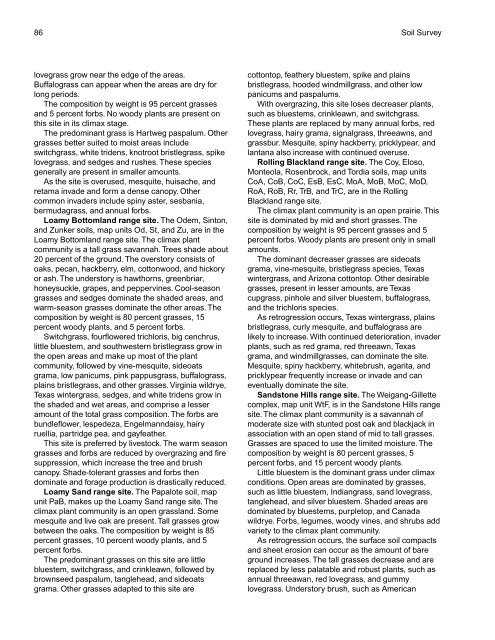Soil Survey of Karnes County, Texas - Soil Data Mart - US ...
Soil Survey of Karnes County, Texas - Soil Data Mart - US ...
Soil Survey of Karnes County, Texas - Soil Data Mart - US ...
You also want an ePaper? Increase the reach of your titles
YUMPU automatically turns print PDFs into web optimized ePapers that Google loves.
86 <strong>Soil</strong> <strong>Survey</strong><br />
lovegrass grow near the edge <strong>of</strong> the areas.<br />
Buffalograss can appear when the areas are dry for<br />
long periods.<br />
The composition by weight is 95 percent grasses<br />
and 5 percent forbs. No woody plants are present on<br />
this site in its climax stage.<br />
The predominant grass is Hartweg paspalum. Other<br />
grasses better suited to moist areas include<br />
switchgrass, white tridens, knotroot bristlegrass, spike<br />
lovegrass, and sedges and rushes. These species<br />
generally are present in smaller amounts.<br />
As the site is overused, mesquite, huisache, and<br />
retama invade and form a dense canopy. Other<br />
common invaders include spiny aster, sesbania,<br />
bermudagrass, and annual forbs.<br />
Loamy Bottomland range site. The Odem, Sinton,<br />
and Zunker soils, map units Od, St, and Zu, are in the<br />
Loamy Bottomland range site. The climax plant<br />
community is a tall grass savannah. Trees shade about<br />
20 percent <strong>of</strong> the ground. The overstory consists <strong>of</strong><br />
oaks, pecan, hackberry, elm, cottonwood, and hickory<br />
or ash. The understory is hawthorns, greenbriar,<br />
honeysuckle, grapes, and peppervines. Cool-season<br />
grasses and sedges dominate the shaded areas, and<br />
warm-season grasses dominate the other areas. The<br />
composition by weight is 80 percent grasses, 15<br />
percent woody plants, and 5 percent forbs.<br />
Switchgrass, fourflowered trichloris, big cenchrus,<br />
little bluestem, and southwestern bristlegrass grow in<br />
the open areas and make up most <strong>of</strong> the plant<br />
community, followed by vine-mesquite, sideoats<br />
grama, low panicums, pink pappusgrass, buffalograss,<br />
plains bristlegrass, and other grasses. Virginia wildrye,<br />
<strong>Texas</strong> wintergrass, sedges, and white tridens grow in<br />
the shaded and wet areas, and comprise a lesser<br />
amount <strong>of</strong> the total grass composition. The forbs are<br />
bundleflower, lespedeza, Engelmanndaisy, hairy<br />
ruellia, partridge pea, and gayfeather.<br />
This site is preferred by livestock. The warm season<br />
grasses and forbs are reduced by overgrazing and fire<br />
suppression, which increase the tree and brush<br />
canopy. Shade-tolerant grasses and forbs then<br />
dominate and forage production is drastically reduced.<br />
Loamy Sand range site. The Papalote soil, map<br />
unit PaB, makes up the Loamy Sand range site. The<br />
climax plant community is an open grassland. Some<br />
mesquite and live oak are present. Tall grasses grow<br />
between the oaks. The composition by weight is 85<br />
percent grasses, 10 percent woody plants, and 5<br />
percent forbs.<br />
The predominant grasses on this site are little<br />
bluestem, switchgrass, and crinkleawn, followed by<br />
brownseed paspalum, tanglehead, and sideoats<br />
grama. Other grasses adapted to this site are<br />
cottontop, feathery bluestem, spike and plains<br />
bristlegrass, hooded windmillgrass, and other low<br />
panicums and paspalums.<br />
With overgrazing, this site loses decreaser plants,<br />
such as bluestems, crinkleawn, and switchgrass.<br />
These plants are replaced by many annual forbs, red<br />
lovegrass, hairy grama, signalgrass, threeawns, and<br />
grassbur. Mesquite, spiny hackberry, pricklypear, and<br />
lantana also increase with continued overuse.<br />
Rolling Blackland range site. The Coy, Eloso,<br />
Monteola, Rosenbrock, and Tordia soils, map units<br />
CoA, CoB, CoC, EsB, EsC, MoA, MoB, MoC, MoD,<br />
RoA, RoB, Rr, TrB, and TrC, are in the Rolling<br />
Blackland range site.<br />
The climax plant community is an open prairie. This<br />
site is dominated by mid and short grasses. The<br />
composition by weight is 95 percent grasses and 5<br />
percent forbs. Woody plants are present only in small<br />
amounts.<br />
The dominant decreaser grasses are sideoats<br />
grama, vine-mesquite, bristlegrass species, <strong>Texas</strong><br />
wintergrass, and Arizona cottontop. Other desirable<br />
grasses, present in lesser amounts, are <strong>Texas</strong><br />
cupgrass, pinhole and silver bluestem, buffalograss,<br />
and the trichloris species.<br />
As retrogression occurs, <strong>Texas</strong> wintergrass, plains<br />
bristlegrass, curly mesquite, and buffalograss are<br />
likely to increase. With continued deterioration, invader<br />
plants, such as red grama, red threeawn, <strong>Texas</strong><br />
grama, and windmillgrasses, can dominate the site.<br />
Mesquite, spiny hackberry, whitebrush, agarita, and<br />
pricklypear frequently increase or invade and can<br />
eventually dominate the site.<br />
Sandstone Hills range site. The Weigang-Gillette<br />
complex, map unit WtF, is in the Sandstone Hills range<br />
site. The climax plant community is a savannah <strong>of</strong><br />
moderate size with stunted post oak and blackjack in<br />
association with an open stand <strong>of</strong> mid to tall grasses.<br />
Grasses are spaced to use the limited moisture. The<br />
composition by weight is 80 percent grasses, 5<br />
percent forbs, and 15 percent woody plants.<br />
Little bluestem is the dominant grass under climax<br />
conditions. Open areas are dominated by grasses,<br />
such as little bluestem, Indiangrass, sand lovegrass,<br />
tanglehead, and silver bluestem. Shaded areas are<br />
dominated by bluestems, purpletop, and Canada<br />
wildrye. Forbs, legumes, woody vines, and shrubs add<br />
variety to the climax plant community.<br />
As retrogression occurs, the surface soil compacts<br />
and sheet erosion can occur as the amount <strong>of</strong> bare<br />
ground increases. The tall grasses decrease and are<br />
replaced by less palatable and robust plants, such as<br />
annual threeawan, red lovegrass, and gummy<br />
lovegrass. Understory brush, such as American
















